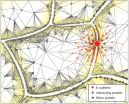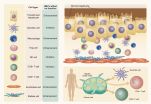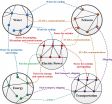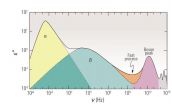(Press-News.org) PHILADELPHIA--Quitting smoking sets off a series of changes in the brain that Penn Medicine researchers say may better identify smokers who will start smoking again--a prediction that goes above and beyond today's clinical or behavioral tools for assessing relapse risk.
Reporting in a new study published this week in the journal Neuropsychopharmacology, James Loughead, PhD, associate professor of Psychiatry, and Caryn Lerman, PhD, a professor of Psychiatry and director of Penn's Center for Interdisciplinary Research on Nicotine Addiction, found that smokers who relapsed within seven days from their target quit date had specific disruptions in the brain's working memory system during abstinence that separated them from the group who successfully quit. Such neural activity--mainly a decrease in the part of the brain that supports self-control and a boost in the area that promotes an "introspective" state--could help distinguish successful quitters from those who fail at an earlier stage and serve as a potentially therapeutic target for novel treatments.
"This is the first time abstinence-induced changes in the working memory have been shown to accurately predict relapse in smokers," said senior author Lerman, who also serves as deputy director of Penn's Abramson Cancer Center.
The study's lead author, Loughead, said: "The neural response to quitting even after one day can give us valuable information that could inform new and existing personalized intervention strategies for smokers, which is greatly needed." Indeed, smoking in the U.S. is at an all-time low in adults; however, there are still 42 million Americans who do smoke, including teenagers and young adults.
In the study, researchers used functional magnetic resonance imaging (fMRI) to explore the effects of brief abstinence from smoking on working memory and its associated neural activation in 80 smokers seeking treatment. Participants were between 18 and 65 and reported smoking more than 10 cigarettes a day for more than six months.
Two fMRI sessions occurred: one immediately after a person smoked and one 24 hours after abstinence began. Following smoking cessation counseling, participants set a future target quit date. Seven days after the target quit date, participants completed a monitoring visit, during which smoking behavior was accessed, including a urine test. Past research strongly suggests that if a person is tobacco free after seven days, they will likely remain that way for six months, if not longer, and is therefore highly predictive of long-term quitting success.
Sixty one smokers relapsed and 19 quit successfully for this period, the researchers reported.
Those who relapsed had decreased activity in the left dorsolateral prefrontal cortex, which controls executive functions, like working memory, compared to those who quit. Working memory is an essential cognitive function necessary for staying focused, blocking distractions, and completing tasks. They also had reduced suppression of activation in the posterior cingulate cortex, a central part of the default mode network of the brain, which is more active when people are in a so-called "introspective" or "self-referential" state.
Past studies have shown relationships between these brain networks. A study in JAMA Psychiatry from Lerman and colleagues published earlier this year showed how smokers suffering from nicotine withdrawal have more trouble shifting from the default mode network into the executive control network, where people can exert more conscious, self-control over cravings and to focus on quitting for good. However, this new study is the first to use that brain activity to help predict relapse in smokers.
Today, there are clinical and behavioral predictors for relapse, including age, the Fagerstrom Test for Nicotine Dependence and other smoking urges and withdrawal tests, but there is much room for improvement.
In the study, researchers determined predictive values of these two relapse models, as well as a new model that includes the working memory data. Using resampling methods that generate 1,000 replicates of the data from the 80 smokers, they found that incorporating the working memory-related brain activity resulted in an 81 percent correct prediction rate, a significant improvement over current models. Without that data, the prediction values were 73 percent for the model of withdrawal symptoms and demographic/smoking history predictors, and 67 percent for demographic/smoking history predictors only.
While broad implementation of neuroimaging assessment is not currently clinically or economically feasible, these changes in the working memory are potential targets for improved assessment instruments, specifically for early smoking relapse. "In addition...predictive models can identify therapeutic targets for pharmacotherapies or neuroscience-based nonpharmacologic interventions to promote smoking cessation," they write.
INFORMATION:
Co-authors of the study include E. Paul Wileyto, PhD, Kosha Ruparel, MD, Mary Falcone, PhD, Ryan Hopson and Ruben Gur, PhD. The research was supported by grants from the National Cancer Institute and National Institutes of Drug Abuse (P50CA143187 and R03DA027438) and the Pennsylvania Department of Health.
Recent research from the Met Office and the University of East Anglia (UEA) suggests breaking the existing global and UK temperature records is much more likely due to human influence on the climate.
Early Figures Suggest Global Record Possible
The global mean temperature for January to October based on the HadCRUT4 dataset (compiled by the Met Office and UEA's Climatic Research Unit) is 0.57 °C (+/- 0.1) above the long-term (1961-1990) average. This is consistent with the statement from the World Meteorological Organization (WMO) today.
With two months of data still ...
Researchers at the Mechanobiology Institute at the National University of Singapore have comprehensively described the network of proteins involved in cell-cell adhesions, or the cadherin interactome. This work was published in Science Signaling (Guo et al. E-cadherin interactome complexity and robustness resolved by quantitative proteomics, Science Signaling, 02 Dec 2014, Vol 7, Issue 354).
Unlocking the complexity of cell adhesion
Many biological processes depend on the ability of cells to stick to one another. The formation of multicellular organisms and precise ...
Plastic is well-known for sticking around in the environment for years without breaking down, contributing significantly to litter and landfills. But scientists have now discovered that bacteria from the guts of a worm known to munch on food packaging can degrade polyethylene, the most common plastic. Reported in the ACS journal Environmental Science & Technology, the finding could lead to new ways to help get rid of the otherwise persistent waste, the scientists say.
Jun Yang and colleagues point out that the global plastics industry churns out about 140 million tons ...
Hepatocellular carcinoma (HCC) is one of the few cancers in which a continued increase in incidence has been observed over recent years. Globally, there are approximately 750,000 new cases of liver cancer reported each year. Importantly, population-based studies show that HCC ranks as the third leading cause of cancer-related deaths worldwide. Also, a large proportion of HCC patients display symptoms of intrahepatic metastases or postsurgical recurrence, with a five-year survival rate of around only 30-40%.
Among the various pathogenic factors, HBV infection accounts ...
Current asthma treatments can alleviate wheezing, coughing and other symptoms felt by millions of Americans every year, but they don't get to the root cause of the condition. Now, for the first time, scientists are reporting a new approach to defeating asthma by targeting the trigger -- the allergen -- before it can spark an attack. They describe their new compound, which they tested on rats, in ACS' Journal of Medicinal Chemistry.
Clive Robinson and colleagues explain that to prevent many health problems, the ideal approach to treatment or prevention involves getting ...
The interdisciplinary field of network science has attracted enormous attention in the past 10 years, although most results have been obtained by analyzing isolated networks. However many real-world networks interact with and depend on other networks.
"The properties and dynamics of interdependent and interconnected networks have been studied extensively, and scientists are finding many interesting results and discovering many surprising phenomena," state scientists based in China, the US and Israel who co-authored a new study, "From a single network to a network of ...
Humans have been experimenting with and utilizing glassy materials for more than ten millennia, dating back to about 12000 B.C. Although glassy materials are the oldest known artificial materials, new discoveries and novel applications continue to appear.
Yet understanding of glass is far from complete, and the nature of glass constitutes a longstanding puzzle in condensed mater physics.
In a new overview titled "The β-Relaxation in Metallic Glasses" and published in the Beijing-based National Science Review, co-authors Hai Bin Yu and and Konrad Samwer, based at ...
In order to observe the impact of climate change on soil microorganisms under as natural conditions as possible, the scientists transferred intact young beech seedlings from a cool, wet, northwest-exposed site of a slope approximately corresponding to present climatic conditions to a warmer site exposed to the southwest. This transfer simulated temperature and precipitation profiles as can be expected from climate change. "We tried to keep initial soil type and nutrient content sin soil as comparable as possible to avoid additional factors influencing our data"," said Prof. ...
With good planning, it is possible to promote the reuse of construction and demolition waste and thereby both conserve the environment and save on material costs. In the future, it will be even more important to assess how buildings can reasonably be repaired or demolished into parts, together with how the remaining service life of the parts can be utilized in new applications. The best method is to implement demolition planning already as a component of construction design.
Reuse of construction parts is always worthwhile from the perspective of the environment, and ...
For years, scientists have been pursuing "artificial leaf" technology, a green approach to making hydrogen fuel that copies plants' ability to convert sunlight into a form of energy they can use. Now, one team reports progress toward a stand-alone system that lends itself to large-scale, low-cost production. They describe their nanowire mesh design in the journal ACS Nano.
Peidong Yang, Bin Liu and colleagues note that harnessing sunlight to split water and harvest hydrogen is one of the most intriguing ways to achieve clean energy. Automakers have started introducing ...




